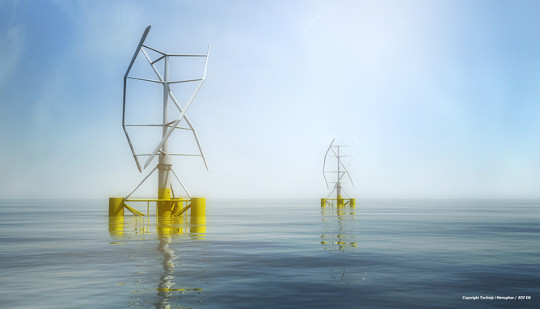
 s wind power companies venture into ever-deeper waters, the traditional windmill-style turbine may not be the most suitable solution. It’s time to look at alternatives.
s wind power companies venture into ever-deeper waters, the traditional windmill-style turbine may not be the most suitable solution. It’s time to look at alternatives.
Wind turbines traditionally had blades that rotate around a horizontal axis, and this has remained standard in modern wind farms. Conventional horizontal-axis wind turbines (HAWTs) came to dominate the wind energy market, both on land and in shallow waters offshore.
But the best wind farm sites are often found in deeper seas, far from wind obstructions, shipping lanes, nimbys and migrating birds. Support structures fixed rigidly to the seabed may not be economically viable in depths beyond 50m, so engineers are instead turning to floating foundations.
These are very different conditions in which to generate electricity from wind, which has meant a re-emerging interest in alternative wind turbine configurations. As we report in Philosophical Transactions of the Royal Society adopting a vertical rotation axis is one such alternative. These turbines, which always face the wind, are known as vertical-axis wind turbines (VAWTs).
Stable Structures
Traditional horizontal-axis turbines are very top-heavy, with the blades and the equipment that generates power necessarily fixed to the top of the tower. In a large offshore turbine this part can weigh several hundred tonnes and be around 100m above sea level.
In a vertical-axis turbine the generation systems can be at a much lower height, even right at the base of the tower. This means VAWTs tend to have a much lower centre of gravity.
On floating supports this advantage is magnified – just think of how stable you are when seated in a canoe rather than standing on it.
Lowering the generators also makes them much more accessible and easier to maintain or replace. For example, with a VAWT workers only need to climb a short distance to access machinery rather than climb a 100m tower that is constantly moving.
Size Matters
In general, bigger wind turbines produce cheaper electricity. This has led to turbines getting ever larger and more powerful, especially offshore where 50m blades are now routine and some are even far bigger.
But such horizonally-rotating giants may soon reach their limit. If the axis of the blade is considered, when this blade is horizontal the gravitational force will be perpendicular to it, while when the blade is vertical (upward) the gravitational force will be parallel to the axis and pointing toward the root of the blade. Finally, when the blade is vertical again (downward), the gravitational force will be parallel to the blade axis, but now pointing toward the tip. Some studies claim this oscillating gravitational load limits the size of horizontal axis turbines.
Vertical-axis turbines resolve this problem because as they rotate they experience a constant gravitational force, always in the same direction. Without the stress of holding up 80m metal blades by one end, VAWTs can potentially become much larger.
Research has also shown vertical turbines can be placed closer to each other in a wind farm. So for a given area, more VAWTs can be installed, and more electricity generated than if HAWTs were used, thereby reducing the cost of electricity.
The Axis Revolution
So now the obvious question arises: why have VAWTs not yet been used if they are so advantageous? The main reason is that it is still a new technology. Although researchers have looked at vertical axes for decades, the technology fell behind due mainly to material and bearing system limitations. Investors still see the known technology as a safe bet and even when looking at deep-sea wind they have been more inclined to support horizontal-axis turbines on floating platforms.
However both governments and forward-thinking companies are now investing in the potential of VAWTs for deep sea offshore wind. The Nova project, funded by the UK government, demonstrated vertical-axis offshore was commercially viable. Sandia National Laboratories, backed by the US energy department, and various EU-backed projects have also supported the technology.
Industrial companies such as the British VertAx Wind or Norway’s Gwind are also following suit through the development of different concepts. The French company Nenuphar is pushing ahead its VAWT design, with plans (pictured at the top of this article) to install the first floating wind farm off the coast of Marseilles.
With increasing demand for energy we are obliged to explore every possible solution. Vertical-axis wind turbines located in the deep sea have strong potential to be one of these solutions.
This article was originally published on The Conversation
Read the original article.
About The Authors
 Maurizio Collu is a Lecturer, Offshore Renewable Energy Centre at Cranfield University. Dr Collu is the Course Director of the Advanced Mechanical Engineering MSc, and a lecturer in Fluid Mechanics and Loading, CEng, MRINA and MEI. He is particularly involved in the conceptual and preliminary design of offshore support structures for the emerging floating wind turbine industry.
Maurizio Collu is a Lecturer, Offshore Renewable Energy Centre at Cranfield University. Dr Collu is the Course Director of the Advanced Mechanical Engineering MSc, and a lecturer in Fluid Mechanics and Loading, CEng, MRINA and MEI. He is particularly involved in the conceptual and preliminary design of offshore support structures for the emerging floating wind turbine industry.
 Michael Borg is currently carrying out postdoctoral research within the Department of Wind Energy at the Technical University of Denmark on floating vertical axis wind turbine concepts supported by the EU-funded DeepWind and INFLOW projects.
Michael Borg is currently carrying out postdoctoral research within the Department of Wind Energy at the Technical University of Denmark on floating vertical axis wind turbine concepts supported by the EU-funded DeepWind and INFLOW projects.
Recommended Book:
Nature's Fortune: How Business and Society Thrive by Investing in Nature
by Mark R. Tercek and Jonathan S. Adams.
 What is nature worth? The answer to this question—which traditionally has been framed in environmental terms—is revolutionizing the way we do business. In Nature’s Fortune, Mark Tercek, CEO of The Nature Conservancy and former investment banker, and science writer Jonathan Adams argue that nature is not only the foundation of human well-being, but also the smartest commercial investment any business or government can make. The forests, floodplains, and oyster reefs often seen simply as raw materials or as obstacles to be cleared in the name of progress are, in fact as important to our future prosperity as technology or law or business innovation. Nature’s Fortune offers an essential guide to the world’s economic—and environmental—well-being.
What is nature worth? The answer to this question—which traditionally has been framed in environmental terms—is revolutionizing the way we do business. In Nature’s Fortune, Mark Tercek, CEO of The Nature Conservancy and former investment banker, and science writer Jonathan Adams argue that nature is not only the foundation of human well-being, but also the smartest commercial investment any business or government can make. The forests, floodplains, and oyster reefs often seen simply as raw materials or as obstacles to be cleared in the name of progress are, in fact as important to our future prosperity as technology or law or business innovation. Nature’s Fortune offers an essential guide to the world’s economic—and environmental—well-being.
Click here for more info and/or to order this book on Amazon.

























